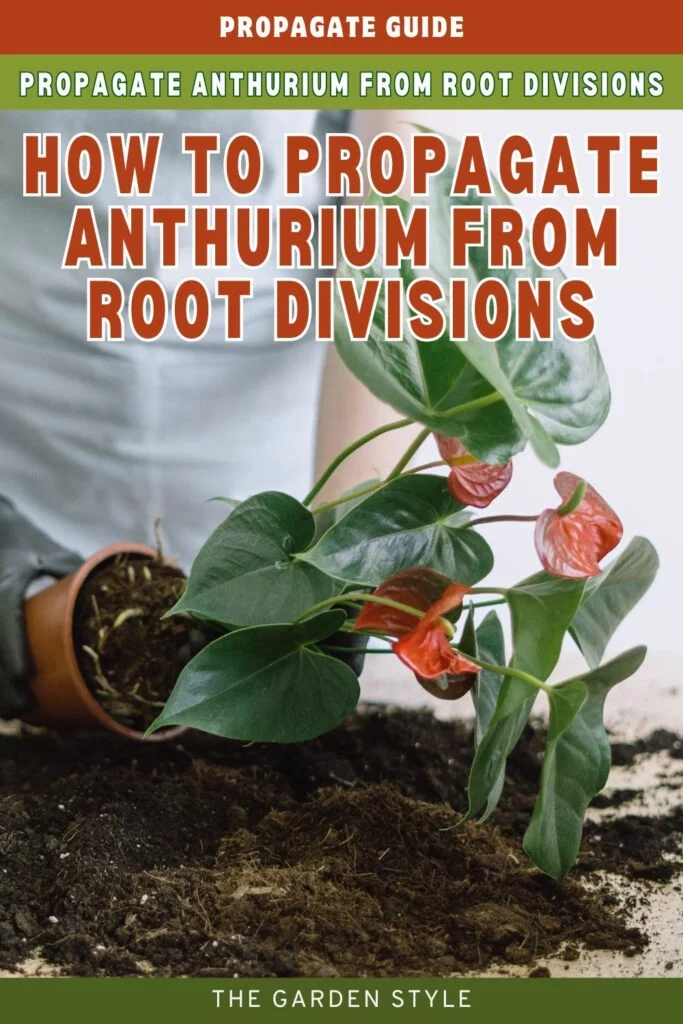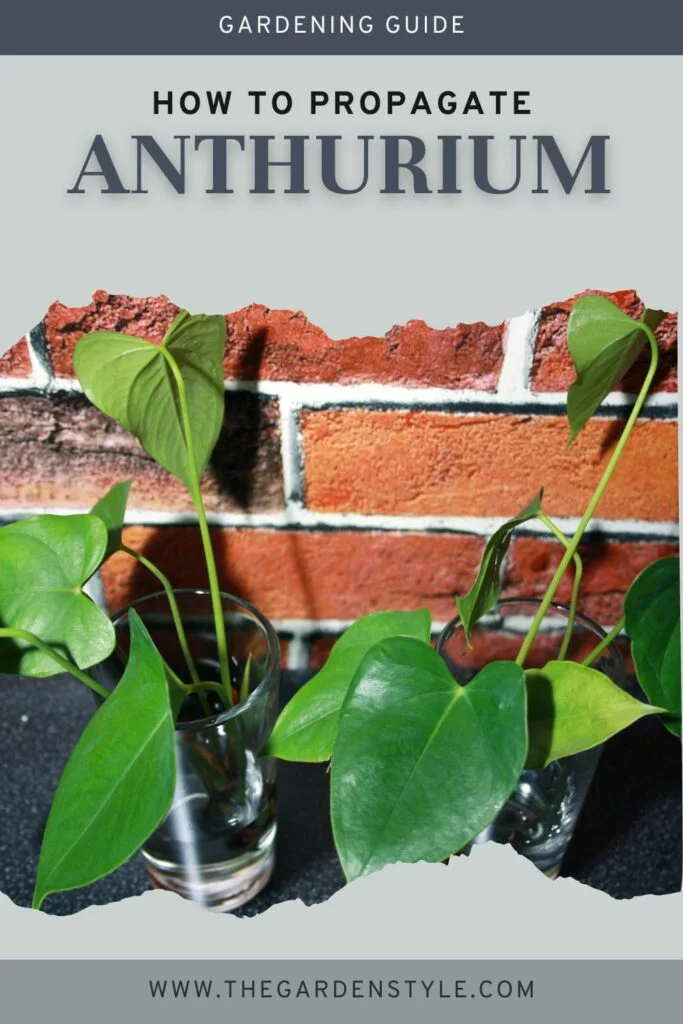Anthurium is an attractive but somewhat expensive plant. So, Can you propagate Anthurium? Yes, you can, and you should do it to keep your Anthurium thriving. In this article, you will learn how to propagate Anthurium (the right way!). Anthurium develops a large number of offshoots throughout its life as a natural way of reproduction. This guide covers the key methods for successfully propagating anthuriums at home, along with the optimal soil, light, and care for getting cuttings to thrive on their own roots quickly.
Table of Contents
The Different Methods for Propagating Anthuriums
Anthuriums, renowned for their stunning foliage and unique flowers, can be propagated through three main methods: cuttings, root divisions, and seeds. Each approach offers its own set of benefits and considerations.
Cuttings
It involves taking a portion of the parent plant, typically a stem or leaf, and encouraging it to develop roots in a new growing medium. Well-suited for anthuriums with healthy, established stems.
Root Divisions
The root division involves the process of separating a mature plant into sections, each with its own roots and foliage, to create new individual plants. It is ideal for mature anthuriums with well-established root systems.
Seeds
Anthurium propagation from seeds involves germinating their seeds to grow new plants. The method is suitable for those who want to experience the full life cycle of anthuriums. Requires patience as seed germination and plant development can take a longer time compared to other methods.
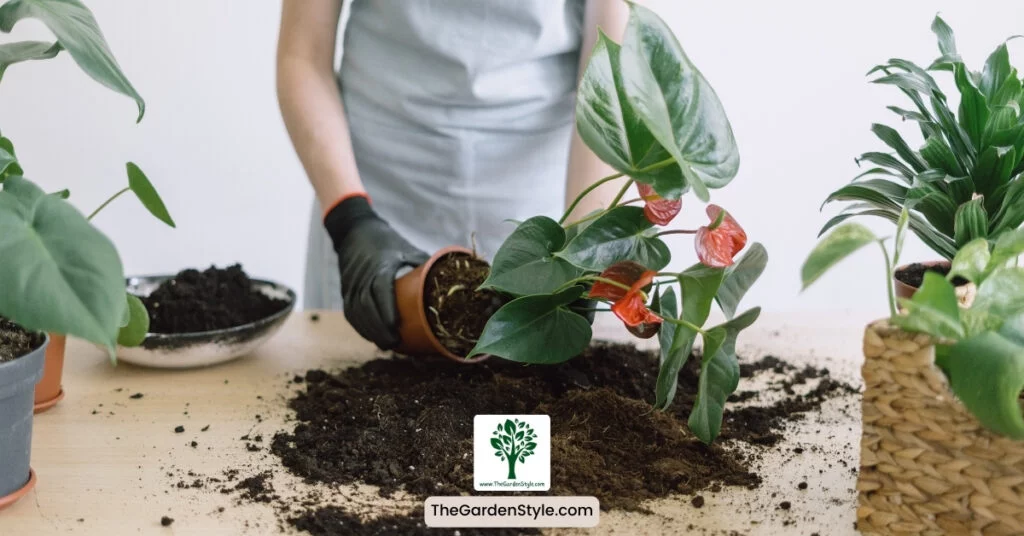
Advantages And Disadvantages of Each Method
Propagation of anthuriums offers multiple methods, each with its own set of advantages and disadvantages. Understanding these aspects can help you choose the method that best aligns with your preferences, resources, and gardening goals.
Advantages and Disadvantages of Propagating Anthurium by Cuttings
Advantages:
- Reliability: Cuttings are a reliable propagation method, often resulting in clones of the parent plant with similar characteristics.
- Faster Establishment: Compared to some other methods, cuttings generally establish roots relatively quickly.
Disadvantages:
- Limited Genetic Diversity: Since cuttings produce identical replicas of the parent plant, there’s limited genetic diversity among the propagated specimens.
- Dependency on Parent Plant Health: Success is contingent upon the health and vitality of the parent plant; if it’s struggling, the cuttings may face challenges.
Advantages and Disadvantages of Propagating Anthurium by Root Divisions
Advantages:
- Preservation of Traits: Similar to cuttings, root divisions preserve the traits of the parent plant, ensuring consistency.
- Quicker Maturity: Divided plants may mature faster than those propagated from seeds, potentially leading to quicker blooming.
Disadvantages:
- Limited Quantity: The number of divisions is inherently limited by the size and structure of the parent plant’s root system.
- Stress to Parent Plant: The division process can cause stress to the parent plant, requiring careful post-division care.
Advantages and Disadvantages of Propagating Anthurium by Seeds
Advantages:
- Genetic Diversity: Seed propagation introduces genetic diversity, potentially resulting in variations among the offspring.
- Educational and Enjoyable: Growing anthuriums from seeds provides a comprehensive gardening experience, from germination to maturity.
Disadvantages:
- Slow Growth: Seed propagation is generally slower compared to other methods, requiring patience for the plants to reach maturity.
- Varied Traits: Due to genetic diversity, the traits of the offspring may differ from the parent plant, making outcomes less predictable.
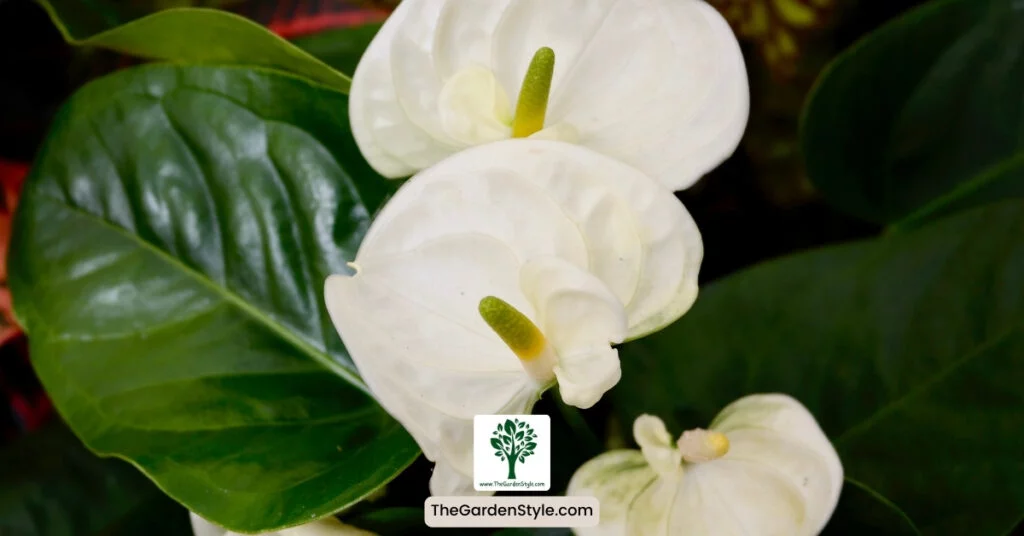
Propagating Tools and Equipment
Propagating an anthurium plant is simple, with just a few basic supplies. At a minimum, you will need:
Cuttings:
- Sharp scissors or pruning shears
- Rooting hormone
- Well-draining soil mix
- Small pots or containers
Root Divisions:
- Clean, sharp knife
- New growing medium
- Individual pots
- Watering can or spray bottle
Seeds:
- Seed trays or pots
- Seed starting mix
- Humidity dome or plastic wrap
- Grow lights or indirect sunlight
- Misting bottle
These basic tools cater to each propagation method, ensuring a smooth and successful process.
- Pamper Your Plants: Hand-blended, 100% all-natural soil mixture; no artificial ingredients
How to Propagate Anthurium from Stem Cuttings
Start with a healthy, pest-free anthurium plant for propagation. Using a vigorous mother plant will give cuttings the best chance to root and grow. When taking a cutting from your own plant or getting one from a friend or online source, carefully inspect it first to ensure it has no signs of disease or insects.
How To Take a Stem Cutting
Taking a stem cutting is a fundamental step in propagating anthuriums. Follow these guidelines for a successful start:
- Choose a healthy parent plant with vibrant foliage.
- Use sharp, sterile scissors or pruning shears for a clean cut.
- Select a stem with at least three to four inches of healthy growth.
- Ensure the cutting includes a node, as this is where roots will develop.
Rooting In Soil
Rooting an anthurium stem cutting in the soil is a common and effective method. Here’s what you need to do:
- Dip the cut end of the stem in rooting hormone to stimulate root growth.
- Plant the cutting in a well-draining soil mix or a combination of perlite and peat moss.
- Place the potted cutting in a warm, humid environment with indirect light.
- Keep the soil consistently moist, and be patient as roots develop over a few weeks to months.
Within a few weeks, new growth will emerge as the anthurium cutting roots. Once established, the young plant can be transplanted into a pot or garden bed.
Rooting In Water
Rooting anthurium stem cuttings in water is an alternative method. Follow these steps:
- Place the cut end of the stem in a container of water.
- Change the water regularly to maintain cleanliness and oxygen levels.
- Once roots are a few inches long, transplant the cutting into the soil.
- Provide appropriate care as the new plant acclimates to its growing environment.
Propagation through stem cuttings is a rewarding and accessible method, allowing you to expand your anthurium collection with genetically identical plants to the parent.
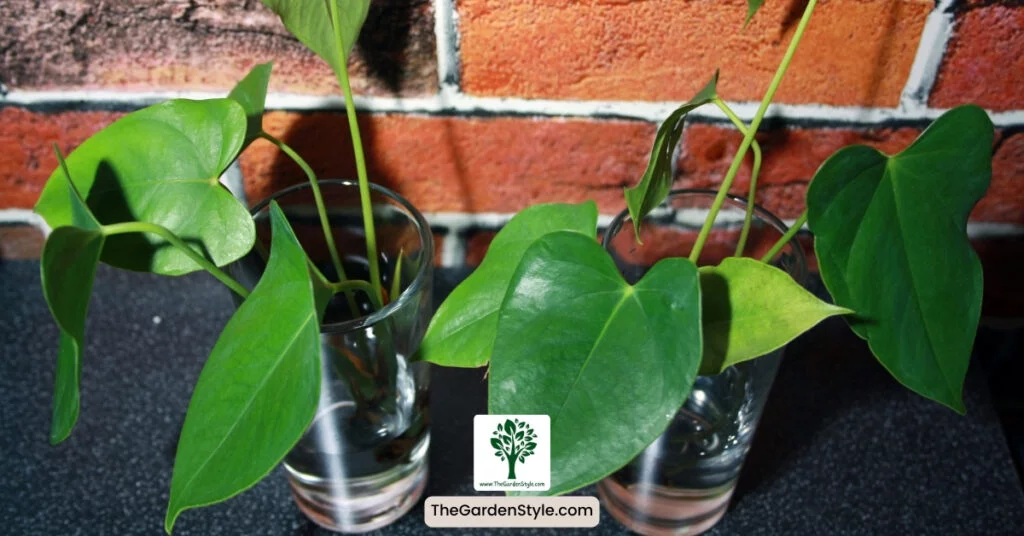
How to Propagate Anthurium from Root Divisions
Dividing anthurium roots is a straightforward process that allows you to create new plants from a mature specimen. Follow these simple steps:
- Select a Mature Plant: Choose a mature anthurium with a well-established root system. This method is particularly effective for plants that have outgrown their current containers.
- Remove from Pot: Gently remove the anthurium from its pot, being careful not to damage the roots. Shake off excess soil to expose the root structure.
- Divide the Roots: Use a clean, sharp knife to divide the root ball into sections. Ensure that each section has both roots and accompanying foliage, aiming for at least two or three stems.
- Repotting: Plant each divided section into an individual container with fresh, well-draining soil. Water the newly potted divisions thoroughly.
- Care and Monitoring: Provide regular care as the divided plants establish themselves. Maintain consistent moisture levels and protect them from harsh conditions during the initial phase.
Dividing roots is a practical method for expanding your anthurium collection, ensuring the continued health and vitality of the new plants.
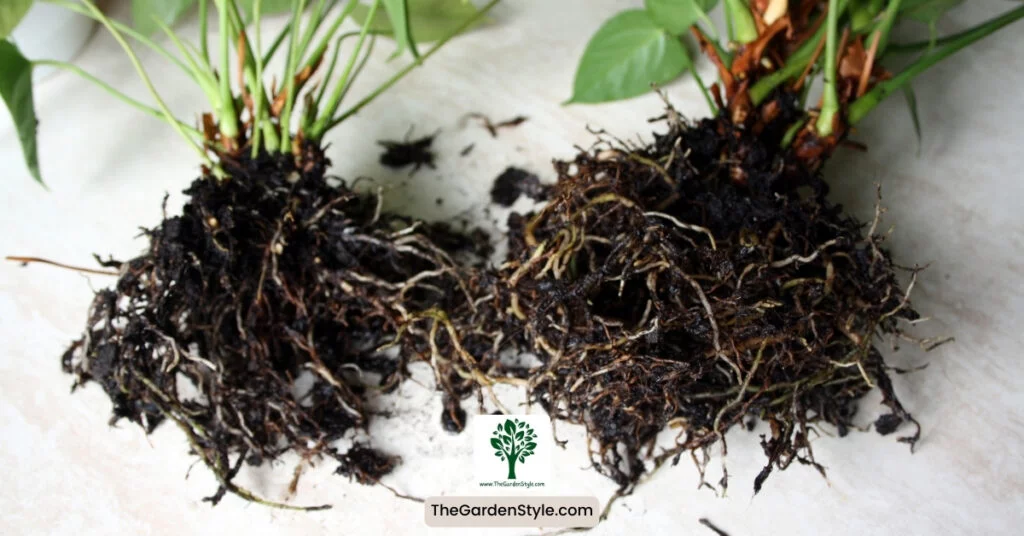
How to Propagate Anthurium from Seed
For anthurium lovers seeking a more advanced, hands-on propagation project, starting with seeds can be an engaging endeavor. Though the process demands great patience and care without any guarantee of germination, nurturing your own plants from seed produces immense satisfaction. Here is the step-by-step.
- Anthurium propagation from seeds demands meticulous sowing, cultivation, and consistent care. We recommend acquiring high-quality seeds to ensure a high germination rate.
- Opt for the best containers for planting anthurium seeds, such as specialized plastic trays designed for seed sowing.
- Prepare the optimal planting medium or substrate by using moistened vermiculite, creating a conducive environment for seed germination.
- Gently press the seeds into the vermiculite, ensuring they are approximately 1.5 inches (3 cm) deep for optimal growth.
- Cover the container or tray with transparent plastic to expedite germination. This technique boosts heat retention and humidity conservation.
- Place the germinating tray in an area with a temperature of at least 69.8°F (21°C). Avoid direct sunlight during this crucial phase.
- If excess moisture accumulates, gradually remove the plastic cover to allow for evaporation. This ensures a healthy environment for the emerging seedlings.
- Once germination is achieved, delicately remove the cover to facilitate further growth.
- Gently transfer the anthurium seedlings to individual pots, providing them the space they need to thrive.
In conclusion, patience is key as small anthuriums may take up to four years to bloom. While propagating anthuriums from seeds may not be the most conventional method, the challenge and satisfaction it brings make it a rewarding gardening hobby.
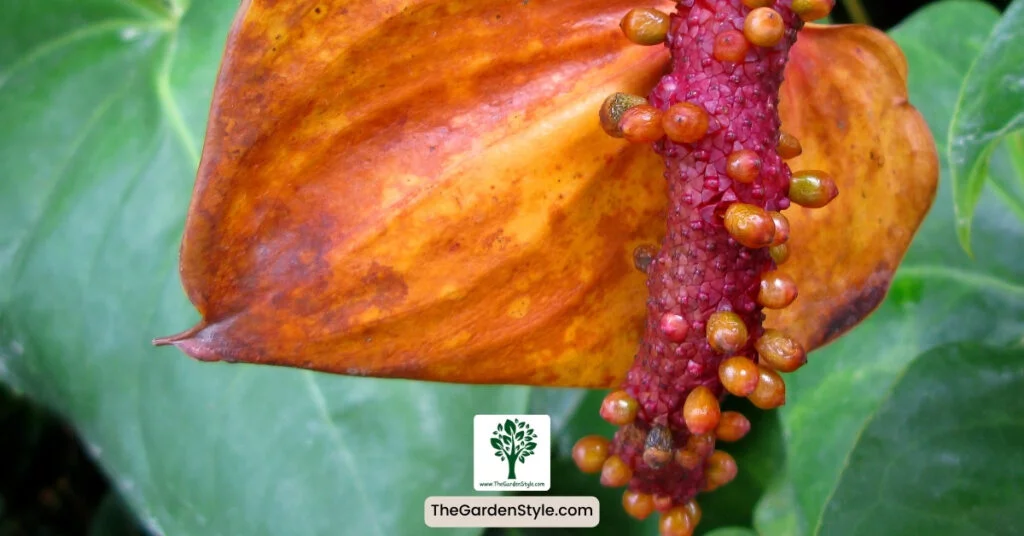
Caring for Anthurium After Propagating
Caring for propagated anthuriums involves attention to their light preferences, maintaining optimal temperature and humidity, choosing the right soil mix, and following a balanced watering and fertilization routine.
Light And Position
Place your propagated anthuriums in bright, indirect light. They thrive in well-lit environments but should be shielded from direct sunlight, which can scorch their leaves. If you’ve recently transplanted or repotted, gradually acclimate the plants to any changes in light conditions to prevent stress.
Recommended reading: Feng Shui Plant Placement: Strategic Allies
Temperature & Humidity
Maintain a consistent temperature between 65-80°F (18-27°C) for optimal growth. Avoid exposing anthuriums to drafts or sudden temperature fluctuations.
Anthuriums prefer high humidity levels to mimic their tropical origins. Use humidity trays, and a room humidifier, or group plants together. Periodically misting the foliage also provides an additional humidity boost.
Soil Type
Plant your anthuriums in a well-draining potting mix. This helps prevent waterlogging, ensures root health, and promotes robust growth. Consider repotting every 2-3 years to refresh the soil.
Watering
Keep the soil consistently moist but not waterlogged. Allow the top inch of the soil to dry between waterings. Adjust the watering frequency based on your specific growing conditions.
Anthuriums are susceptible to root rot if overwatered. Be cautious not to let water accumulate in saucers or trays.
Fertilizer
During the growing season (spring and summer), provide your anthuriums with a balanced, water-soluble fertilizer. Dilute the fertilizer according to package instructions to avoid over-fertilization, which can harm the plants.
Feed every 6-8 weeks and reduce or eliminate fertilization during the dormant season (fall and winter).
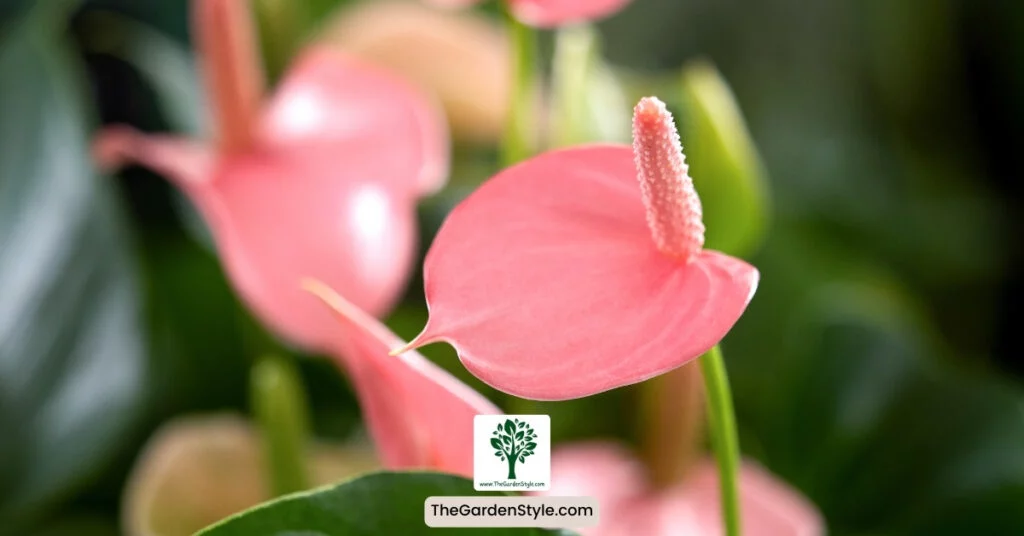
Common Problems After Propagating Anthurium
As you nurture your new plants, you may encounter some common issues. Let’s explore these challenges and how to address them:
Transplant Shock:
- Issue: Newly propagated anthuriums may experience stress or shock after being transplanted.
- Solution: Ensure a gradual transition by acclimating the plants to changes in light, temperature, and humidity. Provide extra care during the initial weeks to help them adapt.
Yellowing Leaves:
- Issue: Yellow leaves may indicate overwatering, underwatering, or a need for nutrient adjustment.
- Solution: Check the moisture level of the soil, adjust your watering routine accordingly, and ensure proper fertilization with a balanced fertilizer.
Pest Infestations:
- Issue: Aphids, spider mites, or other pests can target anthuriums, especially during the propagation stage.
- Solution: Regularly inspect the foliage, and if pests are detected, treat them with insecticidal soap or neem oil. Isolate affected plants to prevent the spread of pests.
Slow Growth:
- Issue: Anthuriums propagated from seeds may exhibit slow growth.
- Solution: Be patient, as anthuriums can take time to establish. Ensure they have the right conditions—adequate light, temperature, and humidity. Adjust fertilization if needed.
Leaf Browning or Burn:
- Issue: Direct sunlight can scorch anthurium leaves.
- Solution: Shield your plants from intense sunlight, especially during the afternoon. If growing indoors, ensure they receive bright, indirect light.
Frequently Asked Questions
Yes, anthuriums can be successfully propagated using various methods such as stem cuttings, root divisions, and seeds. Each method offers unique advantages, allowing gardeners to choose the approach that suits their preferences and expertise.
The ideal time to propagate anthurium depends on the chosen method:
Stem Cuttings: Best carried out during the growing season, typically in spring or early summer when the plant is actively growing.
Root Divisions: Ideally done when the anthurium has outgrown its current container, usually every 2-3 years or when repotting is necessary.
Seeds: Anthurium seeds can be sown at any time, but germination may be faster in warmer months. It requires patience as the process may take several weeks to months.
If this post about how to propagate anthurium was helpful, please share it:
